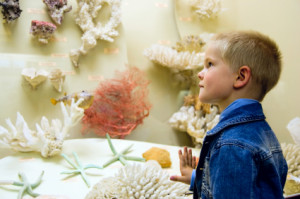Top 9 Natural History Museums in the U.S.

A good natural history museum goes beyond exhibits on animals, plants, evolution, human culture, and so forth—it offers hands-on experiences. It interests visitors in the facts about our natural world that we may take for granted. It breathes life into life. Here are 9 of the top U.S. natural history museums:
#1: Smithsonian Institution National Museum of Natural History – Washington, D.C.
The Smithsonian Institution is the world’s largest museum and research complex. Boasting more than 120 million objects and 325,000 square feet of exhibition and public space—the size of 18 football fields—the Smithsonian Museum of Natural History is among the most impressive in the country. From whales to the Hope Diamond to the human genome, the Smithsonian brings every form of natural history to breathtaking life. An exhibit on soil has never looked so intriguing. Hands-on experiences include Discovery Centers, an insect zoo, a butterfly pavilion, and a forensic lab. And like most D.C. museums, general admission is free (though some special exhibits do charge a fee).
#2: American Museum of Natural History – New York, NY
Though this New York City mainstay is most famed for its gigantic fossil collection, the American Museum of Natural History offers visitors their choice of 45 different halls to explore—including the fascinating Hall of Human Origins and the Hall of Meteorites, the latter of which displays a 34-ton iron meteorite that will make you rethink what you’d do if Bruce Willis called you up and asked you to be on his world-saving team.
#3: The Field Museum – Chicago, IL
Sue, the largest Tyrannosaurus Rex fossil in the world, greets visitors at the entrance of Chicago’s Field Museum, but she’s just one of the museum’s 25 million objects. Beyond the museum’s sophisticated exhibit halls, which allow you to walk through 13,000 years of human history, examine every kind of fossil you can imagine, and learn about conservation—the museum offers interactive and interpretive activities where you can see what your name looks like in hieroglyphics, examine insects in amber, and enjoy a number of opportunities to take your learning “off-script.”
#4: Wyoming Dinosaur Center – Thermopolis, WY
If you’re a dinosaur enthusiast, then the Wyoming Dinosaur Center is your number-one destination. Visitors are invited to marvel at the museum’s collection of specimens—including Triceratops, Stegosaurus, Velociraptor, and even an archaeopteryx, an early bird that marked the transition from dinosaurs to modern birds. The placement of the museum in a tiny Wyoming town makes more sense as you head outside to dig in one of the world’s richest bone fields. Paleontologists are on staff to answer questions and pique your curiosity about earth’s early animal inhabitants.
#5: Carnegie Museum of Natural History – Pittsburgh, PA
Founded by Andrew Carnegie in 1895, the Carnegie Museum of Natural History offers 20 exhibit halls and a sterling reputation for research. Visitors are invited to explore the expected subjects, from dinosaurs to ancient landscapes, as well as consider big-question concepts, such as how humans are affecting the world’s ecosystems. The museum also offers an Experimental Gallery, for which they partner with outside institutions and organizations to offer a fresh perspective on a range of subjects.
#6: Fernbank Museum of Natural History – Atlanta, GA
In addition to permanent exhibits such as an impressive dinosaur collection and Naturalist Center, the Fernbank Museum offers visitors a peek into prehistoric Georgia. Learn the story of our planet’s history as you explore murals, life-like recreations of ancient local landscapes, and the predators that roamed the land before the modern humans arrived. The museum offers hundreds of hands-on exhibits, including the permanent exhibition Sensing Nature, which demonstrates how our senses interpret and rationalize visual, audial, and other sensory cues.
 #7: University of Michigan Museum of Natural History – Ann Arbor, MI
#7: University of Michigan Museum of Natural History – Ann Arbor, MI
Run by one of the country’s best public universities, the UM Museum of Natural History offers four floors of exhibits, including the largest dinosaur collection in the state and an in-house planetarium. The Hall of Evolution traces 600 million years of life on Earth, and the Michigan Wildlife Gallery offers a glimpse into the area’s birds, mammals, reptiles, amphibians, plants, and fungi as well as the largest mastodon track way display in the world. Plan ahead and download a themed scavenger hunt from the museum’s website before your visit.
#8: Bernice Pauahi Bishop Museum – Honolulu, HI
The largest museum in Hawaii and one of the most unique on this list, the Bishop Museum was founded in 1889 and is also known as the Hawaii State Museum of Natural and Cultural history. It is home to the world’s largest collection of Polynesian cultural and scientific artifacts—reflecting the celebrated multicultural background of this American state. The museum’s entomological collection, featuring more than 13 million specimens, is also impressive, and the Library has one of the world’s largest collection of books on Hawaii and the Pacific. The complex itself is a historic work of art; two of the museum’s original buildings, Hawaiian Hall and Polynesian Hall, were built in 1898 and still stand today and are listed on the National Register of Historic Places. The newest building, completed in 2005, offers interactive displays on the state’s specialty attractions, including marine biology and volcanology.
#9: Museum of the Rockies – Bozeman, MT
The Museum of the Rockies is exactly what it sounds like—a museum dedicated to the physical and cultural history of the Rocky Mountains and the creatures who have lived there over the past 500 million years. It offers visitors a number of dinosaur-related milestones, including the largest T-Rex skull in the world and a thigh bone with soft-tissue remains. (So perhaps this could be the best possibility for recreating the disaster wrought by scientists trying to recreate live dinosaurs in the film Jurassic Park.) The specialized focus on the region covers everything from Native Americans to fur traders, and the display called Tinsley House gives a glimpse at a turn-of-the-century home through the eyes of costumed interpreters.



